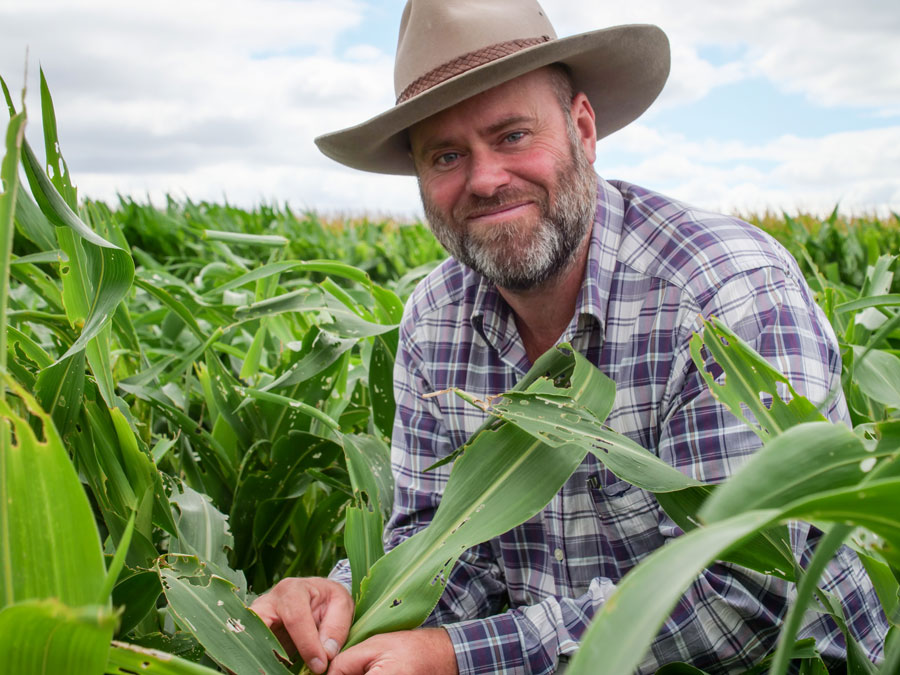Key points
- Fall armyworm was detected in Australia three years ago and poses a major threat to maize and sorghum
- Overseas recommendations on treatment options might not relate to Australian conditions
- Ongoing research will establish the relationship between FAW infestation and yield loss and guide economic decisions on treatment
Guidelines to help growers decide when and how to treat fall armyworm (FAW), with reliable yield loss predictions and economic control thresholds, are being developed.
The exotic pest was detected in Australia three years ago and poses a major threat to broadacre crops including maize and sorghum.
With GRDC investment, the Queensland Department of Agriculture and Fisheries (DAF) is working with the University of Queensland on guidelines.
Despite information from overseas, Dr Joe Eyre from the Queensland Alliance for Agriculture and Food Innovation (QAAFI) says many of those recommendations may not relate well to Australian conditions. “The overseas recommendations for treating fall armyworm are vague, and not in the form of thresholds that Australian growers are familiar with using,” Dr Eyre says.
“We also think the Australian growing environments might require a different approach. The overseas recommendations are to take action based on damage caused by the caterpillars, which may result in crop loss occurring before action is taken, or encourage spraying when the pest is no longer active in the crop. Neither of these are economically efficient nor ecologically friendly strategies for growers to use.”
The research project will establish the relationship between FAW infestation timing, density and crop response.
Canopy size and yield
Speaking at the 2023 Australian Summer Grains Conference, Dr Eyre said the team would first establish FAW’s effects on canopy size.
“We will then predict what impact a modified canopy size has on yield using APSIM (the Agricultural Production Systems sIMulator). This will allow us to robustly characterise the likelihood that FAW damage will impact yield and the magnitude of the yield loss.
“Using these yield loss predictions and growers’ own control costs, we can calculate an economic threshold for FAW control.”
FAW’s arrival in Australia has coincided with a run of La Niña years and the team is keen to research any climatic relationships.
“The current GRDC project will develop the framework to predict yield loss caused by FAW and a tool for simple analysis of loss magnitude in, for example, high, medium and low-rainfall seasons.”

Dr Joe Eyre and his team are first researching the impact of FAW on canopy size. Photo: Megan Pope
Field trials in maize and sorghum at DAF research stations at Gatton, west of Brisbane, and Ayr in north Queensland are already providing valuable information. DAF principal entomologist Dr Melina Miles says there is a lot to learn. “We haven’t had a severe defoliating pest before, and most producers haven’t had to worry about insect pests before flowering.
“Australia’s grains industry is used to having economic thresholds on which to base decisions about the need for, and timing of, pest management and farmers are crying out for guidance because fall armyworm is so damaging and unfamiliar,” Dr Miles says.
The guidelines will be finalised by June 2024. However, Dr Eyre says initial observations demonstrate that quantifying the size of FAW infestation and identifying the crop development stage is critical to effective management.
“This is because not all FAW infestations require control. Ongoing research will establish these critical thresholds.
“Further research is required to inform us on how FAW infestation of crops already stressed from water or nitrogen and short-term forecasts impact the return on investment for FAW control.”
More information: Dr Melina Miles, melina.miles@daf.qld.gov.au; Dr Joe Eyre, j.eyre@uq.edu.au

























































